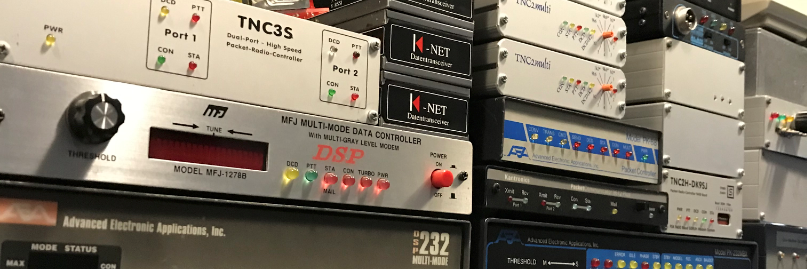[FBB-7.07-AB1FHMRX$]
PI8LAP BBS, Kortgene.
Hello Niels. 549 active messages, last is 2495, last listed is 80.
Assigned channels:
Ch. 5 (TELNET) : PD2LT-0 – Sun 26/03/17 05:40
Ch. 12 (LINK) : PI1LAP-0 – Sun 26/03/17 05:15
(2) PI8LAP BBS>
r 2495
From : PD2NLX
To : INFO@NLD
Type/Status : B$
Date/Time : 25-Mar-17 08:50
BID (MID) : 2495_PI8LAP
Message # : 2495
Subject : Jaarvergadering verslag SRGW
De Stichting Repeater Groep Walcheren heeft onlangs haar jaarvergadering gehouden in
Vlissingen.
Tijdens deze goed bezochte bijeenkomst is kort teruggekeken naar 2016,
daarna is er vooral gekeken naar de toekomst van het repeaterlandschap op Walcheren
en omstreken.
Momenteel zijn drie repeaters gelinkt aan de SRGW: PI1VLI (D-STAR) in Vlissingen-Centrum,
PI2VLI in Vlissingen-Paauwenburg en PI3VLI in Oost-Souburg. Daarnaast is ook een Winlink
opstappunt aanwezig op de locatie van PI2VLI.
=============================
Onderhoud:
=============================
De UHF D-STAR repeater PI1VLI heeft eind december 2016 een nieuwe update gekregen in
zowel de hard- als software. Guus PE1PLM heeft deze repeater in beheer t.b.v. de SRGW.
Sinds december 2016 is PI1VLI gelinkt via Hamnet.
Vanuit de TV toren in Goes en de locatie van de DMR repeater PI1ZLD in Zierikzee loopt het Wifi netwerk naar de locaties in Vlissingen. De VHF stadsrepeater PI3VLI heeft eind december 2016 volledige CTCSS gekregen. Zowel op de in- als uitgang is nu 88,5 Hz aanwezig.
=============================
Plannen op korte termijn
=============================
Sinds 2002 staat in Oost-Souburg de stadsrepeater PI3VLI. Toenmalige reden van het on-air
brengen van een VHF repeater voor Middelburg-Vlissingen was dat de toen regionale VHF
repeater PI3GOE in Wemeldinge geen goed bereik had voor gebruikers op Walcheren.
Inmiddels, 15 jaar later, zijn er hele andere ontwikkelingen op gebied van VHF repeaters in
Zeeland. Zo is er sinds twee jaar de landelijke VHF repeater PI3UTR (145.5750 MHz) en is er
nog steeds vanuit Overslag/Westdorpe PI3ZVL (145.6000 MHZ). Voor de regio Zeeland is de
regio-dekkende VHF repeater PI3GOE (145.7750 MHz) welke uitzendt vanuit de TV toren in
Goes maar ontvangers heeft in Wilhelminadorp, Zierikzee, Kamperland en Breskens.
Met het installeren van Hamnetlink in Vlissingen is er in de vergadering besloten dat een extra
ontvanger voor PI3GOE zal worden geplaatst op de locatie van PI1VLI (Vlissingen-Centrum).
Hiermee zal het porto- en mobiel bereik van PI3GOE uitbreiden op zowel Walcheren als ook in
West Zeeuws-Vlaanderen. Een groot voordeel van een extra PI3GOE ontvanger ( 145.1750 MHz TQ 77,0 ) is dat mobiele stations in Zeeland een prima bereik krijgen over de gehele A58 maar ook op de doorgaande
wegen in Zeeuws-Vlaanderen, Walcheren, de Bevelanden, Schouwen-Duiveland en Tholen.
Wanneer de extra ontvanger van PI3GOE dit voorjaar is geactiveerd, zal een periode
aanbreken van het testen van de dekking, zowel porto- als mobiel bereik.
=============================
Plannen op lange termijn
=============================
In de SRGW vergadering is de VHF repeater PI3VLI uitvoerig besproken. Het doel van de in
2002 geactiveerde repeater lijkt met de komst van de extra ontvanger van PI3GOE in Vlissingen
achterhaald. Gezien het aantal (mobiele) gebruikers en de stadsgewestelijke dekking is
unaniem besloten dat de aanwezigheid van PI3VLI op termijn geen functie meer heeft.
Met de aanwezigheid van twee repeaters op Walcheren (PI2VLI en PI3VLI) en de komst van
een nog betere dekking van PI3GOE op Walcheren is ervoor gekozen dat op termijn de VHF
repeater PI3VLI zal worden uitgezet. Gebruik van PI3GOE zal daarom worden gestimuleerd.
Voordelen van het gebruik van PI3GOE:
– Betere dekking voor mobiele- en vaste amateurstations, verspreid over Zeeland
– Minder versnippering van gebruik van weinig amateurs op meerdere repeaters
– Meer communicatiemogelijkheden tussen amateurs Zeeland-breed
PI3GOE heeft nu al een ruime dekking. Probeer eens op 145.7750 MHz (TQ 77,0)
=============================
Functie PI2VLI
=============================
In de SRGW vergadering is tevens gesproken over de functie van de UHF repeater PI2VLI.
Er is unaniem besloten dat de aanwezigheid van een lokale repeater op Walcheren een wens
blijft. Doordat veel transceivers zowel VHF als UHF kunnen zenden en ontvangen, is besloten
dat de UHF repeater PI2VLI operationeel zal blijven. Op deze manier blijft er voor de regio
Walcheren e.o. een back-up en/of uitwijk frequentie.
Op termijn zullen zowel de SRGW als de lokale afdelingen via de beschikbare middelen het
gebruik van PI2VLI en PI3GOE gaan promoten. Tevens zal er aangekondigd worden wanneer
PI3VLI QRT gaat.
Met de Technoronde op 145.225 MHz, lokale evenementen op PI2VLI ▒n 145.225 MHz, met de
regionale repeater PI3GOE op 145.7750 MHz en de lokale repeater PI2VLI op 430.3375 MHz
hoopt de SRGW, i.s.m. de beheerders van Hamnet en PI3GOE, ook de komende jaren een
goed analoog repeater-bereik te realiseren.
=============================
APRS digi-repeater
=============================
Op de vrij te komen locatie in Oost-Souburg zal een APRS digi-repeater komen welke het
APRS dataverkeer van porto- en mobiele amateurstations op Walcheren zal doorsturen op de
frequentie 144.800 MHz. Hiervoor worden inmiddels de technische voorzieningen voorbereid.
Tot zover de update.
Meer info via www.srgw.nl
— End of message#: 2495 from PD2NLX to INFO —



You must be logged in to post a comment.